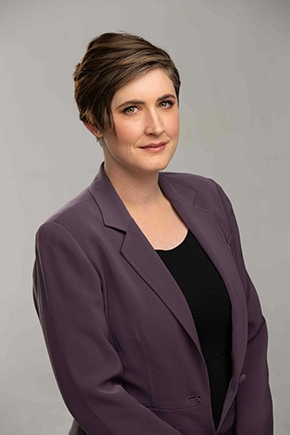BIAAZ Tackles the Link Between Brain Injury and the Opioid Epidemic
The numbers speak for themselves— over 130 Americans die every day from an opioid overdose. In Arizona, the death toll is almost 1,000 per year. But numbers aren’t the only thing speaking. Opioid addiction and overdose have touched the lives of many people who have watched their loved ones— parents, siblings, partners, children, and friends— struggle with this stigmatized disease, and many of them are tired of the silence.
One of the voices being raised belongs to Liz Bradley, the Southern Arizona and Family Support Specialist for the Brain Injury Alliance of Arizona (BIAAZ). At age 20, she was present when her mother received a phone call that changed both their lives. Her Uncle Mike, her mom’s younger brother, had been found dead of an apparent suicide. “My mother made a sound I will never forget and threw the phone on the floor,” Liz remembers.
“We had no idea there was even a problem because the family was too ashamed to talk about it, so it really came out of nowhere,” she shares. “My first reaction was anger for the pain he caused my mom.” In the following weeks, they would piece together what had driven Mike to end his life.
He had been dealing with a painful shoulder injury for years and was prescribed opioid medication for the pain. It did help at first, but then things got out of control. As Liz explains, “sometimes what happens is, a person will lose access to their medication and the pain returns, worse than before. They might also experience withdrawal symptoms, which are really ugly. I don’t blame anyone for not wanting to go through that.”
It can take as few as five days to form a dependence on opioids. Sometimes, folks who have lost their prescriptions will get the drugs elsewhere to avoid the negative effects of being without them. They may request them or steal them from friends and family, buy them on the street, or even turn to heroin, which is more cost-effective.
“I don’t know if he ever got to the point of using heroin, but I do know there was some lying and stealing, and some other actions that tore his young family apart,” Liz recalls. She no longer feels anger toward her uncle, though, as she once did. “I know he was sick, and he needed help,” she acknowledges. “I think he could have gotten help if people weren’t so ashamed to talk about it. That’s why I do what I do.”
 Besides her current role as BIAAZ’s Southern Arizona Outreach and Family Support Specialist, she is also a member of their State Opioid Response (SOR) team. Additionally, she serves as staff support on BIAAZ’s new Statewide Polysubstance Misuse & Cognitive Impairment Workgroup and co-facilitates a support group for family members affected by brain injury and addiction.
Besides her current role as BIAAZ’s Southern Arizona Outreach and Family Support Specialist, she is also a member of their State Opioid Response (SOR) team. Additionally, she serves as staff support on BIAAZ’s new Statewide Polysubstance Misuse & Cognitive Impairment Workgroup and co-facilitates a support group for family members affected by brain injury and addiction.
One of her objectives is to shine a light into the darkness surrounding the opioid epidemic. “When we don’t talk about things, the problem gets worse,” she says. “What we are doing at BIAAZ is highlighting the relationship between substance misuse and brain injury.”
For example, when a person experiences an opioid overdose, oxygen flow to the brain is slowed or halted. This can end in death, but the drug Naloxone can be used to reverse opioid overdose. However, even if a person’s life is saved, there can be lasting consequences. Anoxic and hypoxic brain injuries can occur from the lack of oxygen to the brain.
“People who survive an overdose often have no idea that they may have acquired a brain injury. And statistically, they are likely to overdose more than once,” Liz notes. “Every subsequent overdose means a higher chance of injury to the brain.”
People who misuse drugs are also more likely to experience brain injuries due to falling, vehicle accidents, assault, and domestic violence. Drug misuse often increases the odds for a person’s inclusion in higher risk populations, such as incarceration or homelessness.
On the other side of the coin, people with brain injuries have a high likelihood of being prescribed opioids. They may also be more susceptible to forming a dependency on them and have a harder time overcoming an addiction.
Due to the ever-increasing need, BIAAZ’s SOR team has been tasked with education and prevention initiatives, as well as support for people with brain injuries from opioid overdose, people with brain injury who are struggling with addiction, and people at risk of addiction or injury.
“So far, I’ve been doing a lot of learning,” says Liz. “I have completed courses in Traumatic Brain Injury, Person-Centered Planning, Opioid Overdose Response, Human Subject Research, and Motivational Interviewing. I also recently became a Certified Recovery Support Specialist! I’m excited to go into the community, figure out what is needed, and then fill that need.”
BIAAZ Executive Director Carrie Collins-Fadell agrees. “We’re connecting the dots between opioid addiction and brain injury. That’s why we keep expanding our list of free resources throughout Arizona. Each person has different needs and we’re here to match them with the right resources,” she states.
Carrie couldn’t be more pleased to have Liz as part of the BIAAZ and SOR teams in her integral role. “[She] has only been here since November and is already proving to be a tremendous asset to our team.”
Since starting her journey with BIAAZ, Liz has lost another important person to substance misuse. In April, her former life partner lost his fight with alcohol addiction.
“We were together for nine years, so I feel like a piece of me died with him. It really hurts that I wasn’t able to save him. But I feel lucky that I get to help others like him and my uncle, before it’s too late,” she shares. “I have several close friends who are still battling their own addictions. I’ve seen what it can do to someone’s life. I’m not able to bring back the people I lost, but I want to make sure I’m available for the people who are still fighting.”
Liz encourages anyone who is dealing with a brain injury, substance misuse, or both to call the Brain Injury Alliance of Arizona. “Don’t be embarrassed or ashamed,” she encourages. “Society has made addiction into a morality issue, but it’s not. It is a medical issue, and you deserve treatment and care. We would love to help you find it.”
ABOUT BRAIN INJURY ALLIANCE OF ARIZONA
The Brain Injury Alliance of Arizona (BIAAZ) is the only statewide nonprofit organization dedicated to improving the lives of adults and children with all types of brain injuries through prevention, advocacy, awareness, and education. BIAAZ also houses the Arizona Brain Health Resource Center, a collection of educational information and neuro-specific resources for brain injury survivors, caregivers, family members, and professionals.
What began in 1983 as a grassroots effort has grown into a strong statewide presence, providing valuable life-long resources and community support for individuals with all types of brain trauma at no charge.
The Brain Injury Alliance of Arizona:
- Works with the Congressional Brain Injury Task Force
- Houses Arizona Brain Health Resource Center
- Hosts the Statewide Opioid Use Disorder & Cognitive Impairment Workgroup
- Deploys a Statewide Opioid Use Disorder & Cognitive Impairment Response Team with peer support, training and family wraparound services
- Facilitates the Brain Health Advisory Council
- Manages a Statewide Neuro Info-Line 888-500-9165






